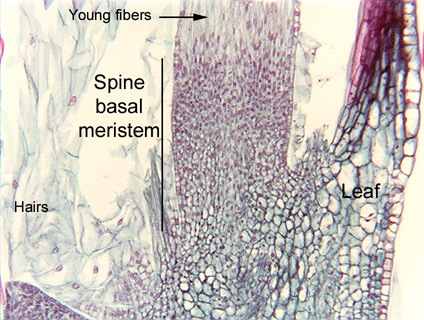 Fig. 6.1-2a. Longitudinal section of a
basal meristem in a
cactus spine (Morawetzia doelziana). Spines grow upward due to a meristem
located at their base; consequently this is a basal meristem. These meristem
cells divide mostly transversely, then enlarge and divide again. As they
enlarge, they push cells above themselves upward. All cells remain meristematic
until they reach a certain level, then they stop dividing, begin to elongate
into fibers, deposit and lignify a secondary wall, and finally die. Meanwhile,
cells in the basal meristem continue to divide and add to the spine. If cactus
spines had apical meristems, their apex would be just soft parenchyma -- not a
very effective deterrent.
Fig. 6.1-2a. Longitudinal section of a
basal meristem in a
cactus spine (Morawetzia doelziana). Spines grow upward due to a meristem
located at their base; consequently this is a basal meristem. These meristem
cells divide mostly transversely, then enlarge and divide again. As they
enlarge, they push cells above themselves upward. All cells remain meristematic
until they reach a certain level, then they stop dividing, begin to elongate
into fibers, deposit and lignify a secondary wall, and finally die. Meanwhile,
cells in the basal meristem continue to divide and add to the spine. If cactus
spines had apical meristems, their apex would be just soft parenchyma -- not a
very effective deterrent.
The structure to the right is the leaf (cacti do have leaves, but they are almost always just a few cells long). The material on the right is a set of hairs that are still alive at this point (you can see some pink nuclei), but cactus hairs typically die quickly and form a mass of dead, waterproof, non-nutritious fuzz that is effective at stopping both cacti and fungi from reaching the nutritious spine basal meristem cells.